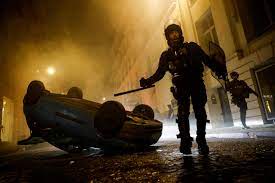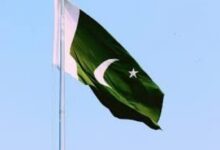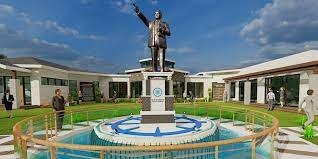Understanding Teenager’s Shooting And Week-Long Violence Spree: France Riots Timeline
The murder of a 17-year-old teenager in a police shooting has sparked violent demonstrations throughout France for the last seven days. Additionally, there were reports of the violence in French overseas territories and a French-speaking community in nearby Switzerland.
Police officers have been assaulted this week, vehicles have been set on fire, public buildings have been vandalized, stores and businesses have been robbed, and at least one prominent local official’s home has been explicitly targeted. The cops have taken many into custody and arrested them.
Since the kid was killed last Tuesday, protestors have flocked to the streets in significant numbers every night, rioting widely throughout French towns. In order to control the situation, which at one point threatened to spiral out of control and remind people of a similar episode in 2005 when the deaths of two people fleeing from police sparked three weeks of widespread rioting that resulted in the declaration of an emergency, 45,000 police officers were deployed to the streets.
There are indications that the situation with law and order is improving, and French President Emmanuel Macron has not yet declared an emergency. After it was revealed that he was at a performance last Wednesday when violence started to spread over France, his personal reputation took a blow. Additionally, Macron was forced to cancel an official visit to Germany, the first by a French president since 2000.
Outlook outlines what started the French demonstrations so that readers may comprehend the sequence of events that led up to them and the subsequent developments.
Calendar of Nahel’s passing
On June 27, a police officer shot and killed Nahel in Nanterre, a suburb of Paris, France. He was mostly known by his first name. He was 17.
The officer who shot Nahel is in detention and has been accused of committing a murder voluntarily. The termination was not legally warranted, according to the French prosecutor handling the case.
Nahel was in a car that the police had pulled over. Two other people were riding in the car.
Two police officers can be seen on the driver’s side of the automobile with their weapons drawn in a video of the event. One cop seems to shoot at the vehicle as it speeds away, and a gunshot-like noise can be heard. The damaged automobile is seen in the latter part of the film as it collides with the roadside.
So far, two different reports of the event have surfaced. On the basis of the current investigation, the prosecutor provided one account. One of the two people who were in the vehicle with Nahel at the time of the shooting provides the second testimony.
Account from the prosecutor
According to the prosecutor’s description of what happened on June 27, it is presumed that the automobile Nahel was riding in had disobeyed police orders to halt, and police were on the lookout for it when it was eventually stopped in a jam of traffic.
According to BBC News, this narrative is based on eyewitness evidence and an examination of CCTV video.
According to this report, the incident began at approximately 8 am when two police officers saw Nahel’s automobile traveling quickly in a bus lane. According to Pascal Prache, the prosecutor for Nanterre, the police attempted to halt the automobile, but it continued to go without permission.
According to Prache, the two police officers launched a pursuit after flashing the occurrence over the police radio.
At 8:16 a.m., the automobile eventually came to a halt in the middle of a busy intersection, and officers with firearms drawn approached it.
“They subsequently admitted to the prosecution that they had aimed their weapons at the driver in an effort to “deter him from driving away again.” The automobile kept moving even after they urged the driver to switch off the ignition. According to the BBC, one of the cops shot, striking the young guy in the chest and killing him.
The passenger next to Nahel’s account
The co-passenger of Nahel said that the automobile veered into the bus lane and that the police pursued it, which is consistent with the prosecutor’s account.
The narrative varies, however, in the incident’s concluding seconds. In an interview with the daily Le Parisien, the other passenger said that the cops repeatedly struck Nahel with the butt of their weapons.
According to the passenger interview, which was cited by the BBC, after Nahel was struck by the officers three times, he let go of the brake and the vehicle sped up. At that point, the police opened fire on him.
“According to this story, Nahel let off of the brake with the third strike, causing the car to accelerate. The passenger said that when the officer shot, Nahel M fell forward and kept his foot on the pedal, according to BCC, who also noted that although the other co-passenger was detained, this co-passenger escaped the scene.
violence in France for a week
For the last week, violent demonstrations have erupted throughout the whole country of France. Police officers have been assaulted, cars have been set on fire, there have been attacks on public buildings, and stores and companies have been robbed. The home of a mayor was also assaulted, and his wife was hurt.
The idea that Nahel’s identification had a crucial role in his demise has fueled the demonstrations. The policeman “saw an Arab face, a little kid, and wanted to take his life,” according to his mother. Nahel was an Algerian-born Arab Muslim.
The first demonstrations started last Tuesday night in the Nanterre neighborhood of Paris, the scene of Nahel’s shooting death. However, starting on Wednesday night, the demonstrations really took up steam.
Wednesday
In Nanterre, protesters—mostly young people—fought with the police while torching automobiles, burning rubbish, and throwing fireworks.
Other public facilities such as police stations and town halls were also assaulted.
According to the New York Times, 170 police officers were hurt while there were close to 200 arrests made.
Thursday
On Thursday, there was an increase in violence, resulting in the burning of almost 2,000 automobiles and the damaging of 500 structures across France. To control the mob, the police resorted to use tear gas shells.
Around 40,000 people had already been stationed around France at that point, but the violence persisted.
The European Union (EU) conference that President Emmanuel Macron was attending in Brussels was cut short.
According to the French newspaper Le Monde, 249 police officers and a total of 667 persons were detained overnight.
Buildings, including schools, were set on fire around France, while shops and businesses were looted and burned.
A Molotov cocktail was used to attack a police station in the Pyrenean city of Pau, and an elementary school and a district office were set on fire in Lille, according to Le Monde. Public buildings were also targeted during the night, including the flagship Nike and Zara stores in Paris.
The newspaper further said that rioters forced open a shopping center’s entrance in the Paris neighborhood of Drancy using a vehicle, and that the center was then plundered and partially burned. Additionally, a library in Marseille was vandalized. In Roubaix, many locations, including a hotel, were also set on fire.
Friday
By that point, 45,000 soldiers had been stationed around France to quell the unrest.
According to The Times, 1,300 people were detained on Friday.
The number of people deployed increased, yet the violence persisted.
“Despite the security presence, looting occurred Friday night in Marseille, Lyon, and Grenoble, with groups of rioters who were often wearing hoods pillaging stores. Cars and garbage cans were also set on fire by protesters.1,350 cars, 234 structures, and 2,560 cases of fires started in public places were also included in the preliminary ministry statistics that were provided early on Saturday, according to Le Monde.
Saturday
Although Saturday was quieter than the previous days, there were still rioters in the streets and arrests were made.
According to the officials, 45 police officers were hurt while more than 700 people were taken into custody.
The automobile assault on Vincent Jeanbrun’s home, who serves as mayor of the Paris neighborhood of L’Ha-les-Roses, was the most violent incident of the evening. The incident, which included involved burning, resulted in injuries to Jeanbrun’s wife.
The perpetrators rammed through the home’s gates with a car before igniting the car so that the fire would spread to the house, according to a statement from the mayor. Then, when his wife Melanie Nowak and their two young children, ages five and seven, attempted to leave, they were assaulted with firework rockets, according to the BBC.
Sunday
Even though Sunday was generally quieter than the previous days, 719 people were arrested, increasing the total number of people in custody to almost 3,000.
Paris showed hints of normality as visitors started to visit landmarks including the Eiffel Tower.
Tourists flocked to the Eiffel Tower in the city’s center where workmen had just put up a clock that would count down to the 2016 Summer Olympics in Paris. A retail center in Nanterre was busy on Sunday with people from all walks of life. Families with the means left for summer vacation, according to The Associated Press.
Monday
On Monday, anti-riot demonstrations were conducted in town halls all throughout France as protester violence continued to decline.
Up to 99 town halls were reportedly assaulted during the rallies, according to the AP.
From Sunday into Monday, 297 cars and 34 structures, many of which were connected to the government, were assaulted around France, according to AP.







